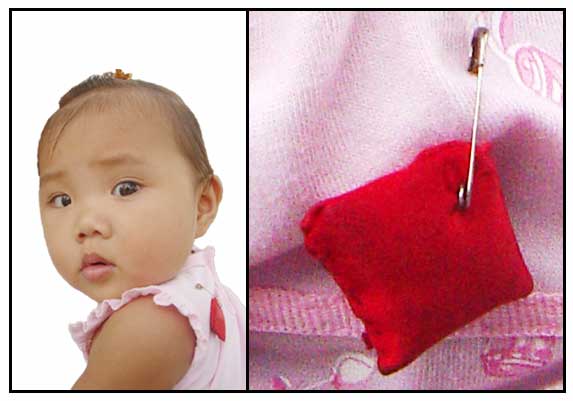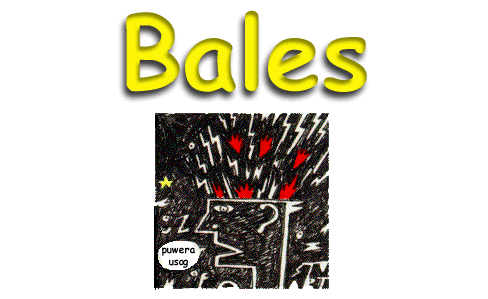|
Bales (na-bati, na-bales) is a condition unique to Philippine folk medicine, deeply embedded in the folklore beliefs of rural folk, a favorite go-to diagnosis by local healers in the rural Quezon areas. Diagnosed in both sexes of all ages, it is most commonly seen in the pediatric population.
Bales (na-bales,
na-bati) is believed to be caused by an admiring or complimentary greeting or comment like: "Your hair looks nice" or "You look good today" or "The baby looks so cute ." It is believed the compliment carries "bad wind" with it, entering the yet weak and defenseless bodies of infants and young children. An immediate verbal antidote (pang-kontra) is to say: "Puwera usog."
| |
 |
|
| |
| Above, a young child pinned
with an "unton." This particular one purchased from an Aita
vendor, believed to be more potent in preventing "bales." It
is left pinned on, night and day, until the child is three or four years
of age, at which time she is believed to be less prone or more resistant
to bales or usog. |
|
|
| |
|
|
A motley of signs and symptoms are attributed to bales, especially when they occur soon after a compliment: Dizziness, loss of appetite, stomach cramps, nausea or vomiting, flatulence (kabag), headaches, and fever. An immediate verbal antidote( pang-kontra) is to say: "Puwera usog."
Treatment
Treatment is varied, some first attempted by family members before calling on the help of the albularyo.
Saliva (laway): If the complimenting person, suspected of causing the bales, is known, he is asked apply his finger-tip wet with saliva, in a cross, on the abdomen or forehead of the person afflicted with bales. If the visit to the patient is not possible or inconvenient, he can also send a small bag of his saliva to be applied as antidote.
| Most rural headaches
are commonly attributed to "bales," even recurrent severe
headaches, especially when unilateral, even with the typical aura,
triggers and history suggest migraine. |
|
| |
|
Herbal remedies: Various herbs have been used, all with perceived efficacy.
• Rice grains: Rice grains are chewed, then applied over the abdomen or forehead.
• Ginger: Chewed raw ginger, applied like rice.
• Atis leaves: Leaves of atis are mashed on salt, then crossed on the abdomen and filling the belly button area with the salted herbal mash.
• Kakawati leaves: Kakawati leaves are chewed, spit on the palm, and then air is gently blown through the rolled palms to the abdomen or forehead.
• Malunggay: A small branch of malunggay with leaves is gently pat on the patient's back.
• Nga Nga: Requiring the expertise of the albularyo, the treatment involves a whole body application of nga-nga ingredients: areca nut, litlit leaves, apog and tabakong intsik.
Other treatments:
• Bulong, Orasyon, Tapal: These are other alternative modalities used by albularyos and other folk healers for bales. Bulong is a prayer in pig-latin, whispered in the course of treatment by the folk healers; in bales, the prayer is delivered with a whispered while applying saliva or blowing herbal essences to the abdomen or forehead. The orasyon is the same pig-latin prayer written in a small piece of paper and pasted as tapal on the abdomen or forehead.
• Mangdudura: Literally, a spittle specialist, a laypersons believed to possess the ability to more effectively counter bales-induced headaches, using the same procedure of chewing various herbs and dabbing and crossing it with his/her thumb over various body parts.
• Unton: Unton is a preventive measure used for infants and young children prone to bales. It is usually a pouch or small sac filled with various indigenous ingredients—seeds, leaves, tree bark, tobacco, carabao horn, etc—and pinned on the child's upper clothing.
Urban-based doctors will surely look at bales with amusement, if not denigration or disdain. However, bales is deeply embedded in the folklore credo of rural healthcare. Many of the signs and symptoms are almost always benign and self-limited—except for the few occasions when the complaints may be prodrome or sign of a more serious condition—and would have resolved with tincture of time. Certainly, for bales, given the benign nature of the malady, the ministration by the local healers, using a bulong, orasyon, tapal or a smear of saliva is a lot less expensive than the cost of a visit to the doctor and his prescription, and perhaps, safer. |




![]()
